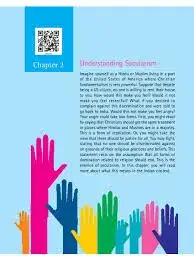NCERT Solutions-Chapter 2-Understanding Secularism Class – 8
Social Science
……………………………………………………………………….
Exercise Question Answers
********************************************
Question 1. List the different types of religious practices that you find in your neighbourhood. This could be different forms of prayers, worship of different gods, sacred sites, different kinds of music and singing, etc. Does this indicate freedom of religious practices?
Answer:
The different types of religious practices that we can see in our neighbourhood are as follows:
- A Sikh person worships in Gurudwara to Guru Nanak using Guru Granth Sahib
- A Muslim worships in a mosque and their sacred book is the Quran.
- A Christian worships Jesus Christ in a Church and their religious book is the Holy Bible.
- A Hindu worships in a Temple to the idols of Gods and Goddess
Question 2.
Will the government intervene if somereligious group says that their religion allows them to practice infanticide?
Give reasons for your answer.
Answer:
The government will surely intervene if some religious group says that their religion allows them to practice
infanticide. Needless to say that the practice of infanticide is a crime. Under this practice the life of a newly-born child is killed. The law does not allow anyone to kill a life.
Question 3.
Complete the following table:
Answer:
Question 4. Look up the annual calendar of the holidays of your school. How many of them pertain to different religions? What
does this indicate?
Answer:
Holidays in a school calendar for different religions:
Question 5.
Find out some examples of different views within the same religion.
Answer:
Different views are followed even within the same religion. As for example, only in the Hindu religion, we have hundreds
of deities worshipped by different groups of people. Similarly, in the Muslim community, there are Shiyas and Shunnis. In Jainas, there are Shwetambar and Digambar sects. In Buddha Dharma, there are Hinayaans and Mahayaans.
Question 6.
The Indian State both keeps away from religion as well as intervenes in religion. This idea can be quite confusing.
Discuss this once again in class using examples from the chapter as well as those that you might have come up with.
Answer:
1. India is a land of complex ideas. It is difficult to understand what it really wants.
2. There are many ideals in the Constitution but practices are quite different from them.
3. In many cases we see laws explain a concept in a different way.
4. But people interpret it differently. Law itself in some cases acts differently.
As for example, in secular state law has nothing to say in any of the practices of the religion but when the dominance of upper castes in religion was brought to question the law took favour of the lower castes. This interference of the State creates confusion.
********************************************
EXTRA QUESTIONS
********************************************
Q1. What means Secularism?
Answer: Secularism means there is no official religion of the state. All religions are equal before law.
Q2. What is Indian Secularism?
Answer:
The Indian Constitution mandates that the Indian State be secular.
According to the Constitution, only a secular State can realize its objectives to ensure the following:
1. that one religious community does not dominate another;
2. that some members do not dominate other members of the same religious community;
3. that the State does not enforce any particular religion nor take away the religious freedom of individuals.





Thanks sir
Hcy